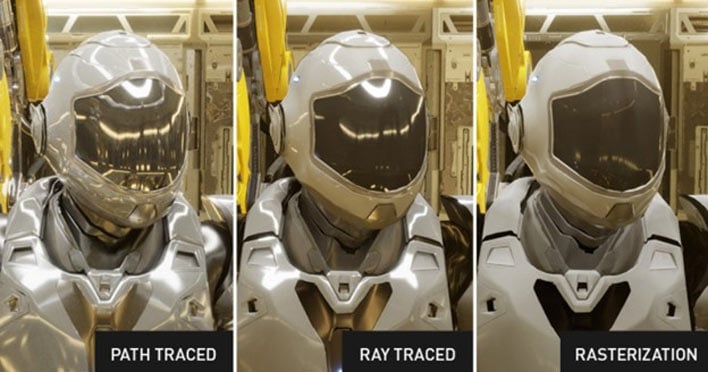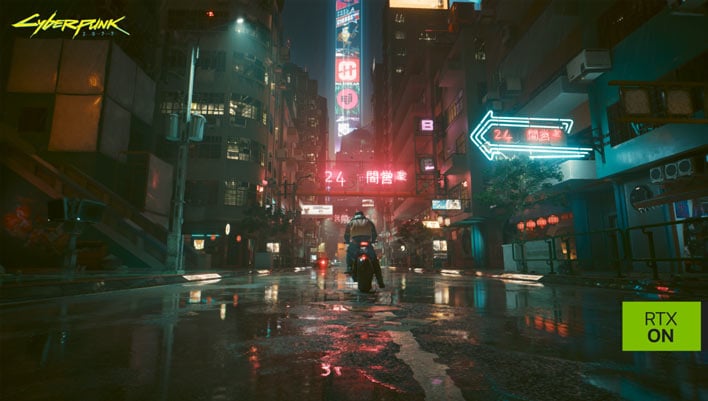NVIDIA Showcases Cyberpunk 2077 Overdrive Mode With Delightful Path-Tracing Coming Soon
Graphics chip maker NVIDIA and game developer CD Projekt Red have showcased a stunning new version of Cyberpunk 2077 at the Game Developers Conference (GDC) in San Francisco as promised. The key change to this already graphically glorious PC gaming title is the implementation of path tracing. This means that ray tracing graphics technology isn’t just sprinkled sparsely here and there, this is “full ray tracing,” with accurate lighting simulation applied throughout the viewed scene.
The implementation of path tracing in Cyberpunk 2077 is variously characterized as providing a “beautiful” and more “immersive” experience, based on technologies that are used by visual artists to create scenes “indistinguishable from reality.” We'll leave the merits of that assessment up to the reader. When NVIDIA debuted RTX real-time ray tracing with the Turing generation, the use of the technology to render a few ray-traced highlights (one or more of reflections, shadows or opacity effects) was rather impactful on performance.
Now with the release of the Ada Lovelace GPUs, alongside supportive technologies like DLSS 3, the green team (and friends) are hoping to inspire top-end GPU sales with path tracing. What we are seeing with path tracing and Cyberpunk 2077, could be the start of a trend if NVIDIA gets its way. It is the first modern AAA title to get the path tracing treatment, with prior toes-dipped-in-the-water limited to the likes of Minecraft, Portal and Quake II. DLSS 3 is a key enabler of path tracing, as NVIDIA admits it allows game engines “to render 1/8th of the pixels, then uses AI and GeForce RTX Tensor Cores to reconstruct the rest.” Some may consider that cheating, but independent analysis of DLSS 3 has not been overly critical, even though graphics geeks are famously pernickety.
Earlier this month we provided some background to the new path-traced Cyberpunk 2077 “Overdrive” graphics mode. We explained that on top of the ray tracing techniques we have grown accustomed to seeing in PC games over the last few years, the RT Overdrive mode will include RTX Direct Illumination (RTXDI), Shader Execution Reordering (SER), Opacity Micromaps, and NVIDIA's Real Time Denoisers – as well as RTX Global Illumination (RTXGI).

As an illustration of the depth of ray traced effects delivered by its new path tracing implementation NVIDIA shared the above image (sorry, low-res source). You can clearly see that the path traced space suit offers extremely detailed reflections across nearly all its surfaces. It is understandable that the visor reflects images so intensely, but perhaps the graphics artists have over-egged the pudding, with the whole suit being extremely reflective.
Remember, NVIDIA released the Path Tracing SDK for devs earlier this week. This opens up the technology to developers beyond the circle of big-name software houses that can budget for a visiting team of NVIDIA engineers.
The implementation of path tracing in Cyberpunk 2077 is variously characterized as providing a “beautiful” and more “immersive” experience, based on technologies that are used by visual artists to create scenes “indistinguishable from reality.” We'll leave the merits of that assessment up to the reader. When NVIDIA debuted RTX real-time ray tracing with the Turing generation, the use of the technology to render a few ray-traced highlights (one or more of reflections, shadows or opacity effects) was rather impactful on performance.
Now with the release of the Ada Lovelace GPUs, alongside supportive technologies like DLSS 3, the green team (and friends) are hoping to inspire top-end GPU sales with path tracing. What we are seeing with path tracing and Cyberpunk 2077, could be the start of a trend if NVIDIA gets its way. It is the first modern AAA title to get the path tracing treatment, with prior toes-dipped-in-the-water limited to the likes of Minecraft, Portal and Quake II. DLSS 3 is a key enabler of path tracing, as NVIDIA admits it allows game engines “to render 1/8th of the pixels, then uses AI and GeForce RTX Tensor Cores to reconstruct the rest.” Some may consider that cheating, but independent analysis of DLSS 3 has not been overly critical, even though graphics geeks are famously pernickety.
Earlier this month we provided some background to the new path-traced Cyberpunk 2077 “Overdrive” graphics mode. We explained that on top of the ray tracing techniques we have grown accustomed to seeing in PC games over the last few years, the RT Overdrive mode will include RTX Direct Illumination (RTXDI), Shader Execution Reordering (SER), Opacity Micromaps, and NVIDIA's Real Time Denoisers – as well as RTX Global Illumination (RTXGI).

As an illustration of the depth of ray traced effects delivered by its new path tracing implementation NVIDIA shared the above image (sorry, low-res source). You can clearly see that the path traced space suit offers extremely detailed reflections across nearly all its surfaces. It is understandable that the visor reflects images so intensely, but perhaps the graphics artists have over-egged the pudding, with the whole suit being extremely reflective.
Remember, NVIDIA released the Path Tracing SDK for devs earlier this week. This opens up the technology to developers beyond the circle of big-name software houses that can budget for a visiting team of NVIDIA engineers.



